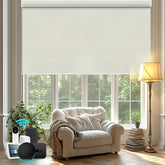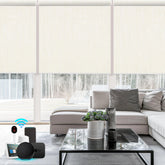Blinds vs Shades: Which Window Covering Fits Modern Homes Best?
Blinds vs shades continue to appear controversial in the current housing design. Homeowners would like to have window treatments that are fashionable, private, and efficient.
The decision between blinds and shades is based on the lifestyle, the decor style, and the form of comfort that one wants to achieve in every space.
Blinds vs Shades: Understanding the Basics

It is necessary to know what makes blinds and shades different before comparing the details.
Blinds: these are window dressings of horizontal or vertical slats, typically of wood, faux wood, vinyl, aluminum, or composite. They are tiltable with control over light and privacy.
Shades: Shades are constructed out of one piece of fabric or material as opposed to blinds. They could be rolled, folded, or pleated to cover the window. Shades are of different varieties, including roller shades, Roman shades, cellular shades, and woven wood shades.
Concisely, blinds are made with slats, whereas the shades have a fabric-like appearance. They both have the same use of light control and privacy, but the design and functionality vary.
Key Differences in Blinds & Shades
In choosing which one best fits the modern houses, there are a number of factors. Comparing blinds and shades with what is most important to the homeowners is a good idea.
1. Style and Design Appeal
The blinds are minimalistic and organized. They are a perfect fit in the modern, industrial, and contemporary houses. Wooden blinds are warmer, and aluminum blinds match a smooth and modern interior.
Shades are slightly tilted to a softer and opulent look. They are available in innumerable fabrics, textures, and designs, hence suitable in snug, contemporary, or interim houses. Clean line roller shades are common in the minimalistic interior design, whereas Roman shades provide an upscale look.
Verdict: Shades are more flexible in terms of design, and blinds have a classicized, organized appearance.
2. Light Control and Privacy

Blinds can be perfectly controlled in light, as the slats can be tilted to change the brightness. They suit well in rooms that require fluctuating degrees of natural light during the day.
Shades prevent or screen light according to the thickness of the fabric. The filtering shades can be light-filtering, and the blackout shades suit bedrooms. Nonetheless, the shade color cannot be tilted to the same extent as the blinds with regard to sunlight control.
Conclusion: Blinds are more useful in fine light management, and shades are useful in soft and general light sifting.
3. Energy Efficiency
Blinds provide average insulation. They are useful in excluding direct sunlight and are not as effective in capturing heat or cold air.
Shades, particularly cellular shades, are very good at energy conservation. Their honeycomb design traps air, which helps to control the temperature in the interior, hence minimizing energy expense.
Conclusion: Shades are less energy-consuming, and thus the best choice to use in homes that are eco-friendly.
4. Durability and Maintenance
Blinds are resistant and simple to manage. They are kept clean by a swift dusting/wiping. Wood blinds can be more expensive to take care of than faux wood or aluminum, which lasts longer.
The shades should be cleaned more attentively. Fabric shades accumulate dust, and they may need to be vacuumed or cleaned professionally. They also wear and tear easily as opposed to blinds.
Final Decision: Verdict in favor of Blinds because of its durability and easy maintenance.
5. Cost Comparison
Blinds tend to be lower priced. Faux wood, aluminum, or vinyl blinds are relatively cheap in cost, whereas wood blinds may cost more.
Shades vary widely in price. Roller shades cost less than designer Roman or motorized cellular shades, which are expensive.
Conclusion: Blinds will be cheaper than the shades, which will be more upmarket.
6. Smart Home Integration
Blinds: Motorized blinds are becoming more common, and it is possible to have them integrated with a smart home (such as Alexa or Google Home). They provide the opportunity to schedule light and privacy automatically.
Shades: Motorized shades are gaining popularity. The cellular shades and roller shades can be easily connected with smart home hubs and provide seamless automation.
Conclusion: Shades is marginally superior in terms of smart technology implementation.
Best Rooms for Blinds & Shades
Blinds are the best suited for the kitchen, bathroom, and office because they are easy to clean and durable. Aluminum and Faux wood blinds are resistant to moisture.
Shades are more suitable in the bedrooms, living rooms, and media rooms where filtering benefits, including softness and style, are more valued.
In short, Blinds suit useful spaces; shades suit comfort-driven spaces.
Popular Types of Blinds

As a comparison between blinds and shades, it is useful to look at the various kinds of blinds. Both alternatives have their own advantages when it comes to style, longevity, and functionality:
Wood Blinds: Introduce a natural, cozy, and classic look to the interiors. Made of old-fashioned or country-style, they bring depth and exquisite style.
Faux Wood Blinds: These are an affordable substitute for real wood, which does not get wet due to moisture, and it is suitable in the kitchen and bathroom.
Aluminum Blinds: These blinds are lightweight, durable, and easy to maintain, and are known to possess a sleek and modern look. Great for minimalist spaces.
Vertical Blinds: This is an effective sliding door and wide window product that has superior light control and a modern appearance.
Composite Blinds: Composite blinds consist of an amalgamation of materials that appear to resemble real wood; however, they are more resistant and durable, and do not warp and fade.
Blinds have always been the favorite of the homeowner who wants convenient and affordable window dressing that is both dependable and attractive.
Popular Types of Shades

Shades add fashion, gentleness, and sophistication in contemporary houses. Having numerous choices of design, they may fit any decor and enhance comfort and performance:
Blackout Roller Shades: Have a simple and clean appearance, with customizable fabric options, including blackout, light-filtering, etc., which makes them fit any room.
Roman Shades: These have a luxurious touch; they can be utilized in any living room, bedroom, or official space, as their sweeping folds make them look nice.
Cellular Shades: This is a high energy efficiency with its honeycomb construction, which offers insulation and thus reduces the energy bills and keeps homes comfortable.
Woven Wood Shades: Made in natural wood such as bamboo, they are both eco-friendly and organic in nature, and they contribute coziness and texture to the interior.
Sheer Shades: Use the ease of cloth with the functionality of blinds that will provide privacy, the grace of design, and provide light diffusion that is beautiful to be layered.
Shades are a trendy addition to any room and are a perfect complement to any modern home of the era, whose inhabitants care about style, comfort, and environmental sustainability.
Blinds vs Shades: What's in Trend Now?
Both of them are trendy. The real question is: how would you like your home to be?
- Sustainability: Green materials and designs.
- Smart Homes: Smart blinds and shades that follow the daily schedule.
- Minimalism: Modern interiors that are minimalist in lines and neutral.
- Customization: Custom design, textures, and fabrics.
Blinds and shades are being developed to match such needs, but the shades are leading in the flexibility of designs and intelligent integration.
Blinds vs Shades: Feature-by-Feature Comparison
| Features | Blinds | Shades |
| Style Options | Moderate | Wide variety |
| Light Control | High | Medium |
| Energy Efficiency | Moderate | High |
| Durability | High | Medium |
| Maintenance | Easy | Requires care |
| Cost | Budget-friendly | Varies (low to high price) |
| Smart Integration | Growing | Advanced |
| Best For | Kitchens, bathrooms, offices | Bedrooms, family rooms, media rooms |
How to Choose Between Blinds and Shades?
In choosing the appropriate choice for your home, you have to consider at least these factors:
- Room usage: Does comfort matter or durability?
- Light requirements: Does it require complete control or light filtering?
- Budget: Do you want to be cost-effective or fashionable?
- Energy efficiency: Does saving on heating and cooling matter?
- Design style: Are you an organized or a soft and elegant person?
Your answers to these questions will help you to decide whether blinds or shades would be the most convenient in your modern home.
Blinds vs Shades: Which Fits Modern Homes Best?

Shades and blinds have their own advantages.
The unique feature of blinds is their durability, low cost, and ability to regulate the lighting. Instead, Shades are the leaders in power savings, style, and intelligent technology.
In the case of the modern homes this year, the shades would be fitting more when comfort, design, and saving energy are the main priorities. Blinds are still the most preferred when one wants to have a room or area that is easy to maintain and durable.
What People Say About Blinds vs Shades
1. Light Control & Flexibility
Many homeowners appreciate the precise control of blinds. As some noted, “Blinds can be manually adjusted to let light in as much as I want, block it completely, or keep the outside view clear while maintaining privacy.”
Tilting slats gives blinds an edge for rooms that need varying light levels throughout the day. In contrast, shades tend to be all-or-nothing — either fully open or fully closed, offering less flexibility for partial lighting.
2. Room Ambiance & Compatibility
Users who’ve tried both emphasize that blinds pair well with drapes, just like shades do. Some commented that while shades may create a darker, cozier room, blinds are better for balancing daylight and privacy:
“I can tilt them to block direct light or view while still letting diffuse light in. Blinds and drapes work just as well together as shades and drapes.”
They also mentioned that shades can look softer and are often easier to install, especially if curtains are layered in front.
3. Maintenance & Durability
When it comes to upkeep, opinions are mixed. Some of our users pointed out, “Blinds can be harder to clean — all those individual slats — and they can show small damage more easily.”
However, blinds may still win in the long run for durability and easy repairability, especially compared to fabric shades that collect dust more quickly.
That said, vertical blinds drew criticism for being inconvenient in pet-friendly homes or on large sliding doors, as “they can be a huge pain if you have pets.”
Summary Insight
From these real experiences, blinds stand out for adjustable light control and durability, while shades earn praise for simplicity, softness, and ease of installation.
Conclusion
The blinds and the shades debate is still on, but the choice can be made according to the way of life, the design objectives, and the budget. Shades are the top choice among the modern residential buildings where energy efficiency, comfort, and stylish flexibility are greatly appreciated. Blinds are a sure option in terms of utility and cost.
We are engaged in offering quality, up-to-date, and trendy window dressing that suits the changing demands of households.
And either you are attracted to the organized appearance of the blinds, or you would like to enjoy the lightness and lightness of the shades, we have the solutions that combine both functionality and aestheticism.
We want to make you change your dwelling places by providing window covers that are in line with the current trends and the future expectations.
Come and visit Bringnox!
You May Also Like to Read
Window Treatment Trends: Guide to Window Blinds & Shades
How to Choose Blackout Blinds: Read This First!
Light Filtering vs Blackout Shades
Roman Shades vs Woven Wood Shades: Best Choice for Your Home




